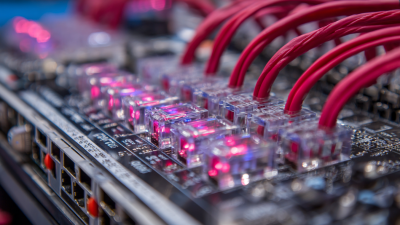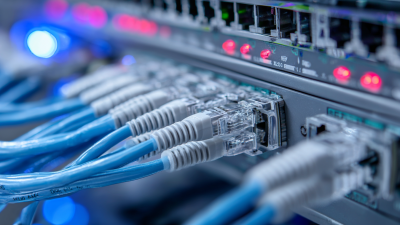
- hasivo@hasivo.com
- Mon - Sat at 7:00AM to 9:00PM
Leave Your Message

 The advent of 2.5G switches has marked a significant evolution in network infrastructure, providing a bridge between traditional 2G systems and more advanced 3G technologies. As organizations increasingly rely on robust data communication solutions, the performance of these switches becomes paramount in determining overall network efficiency and reliability.
This deep dive into recent industry trends will explore how 2.5G switches enhance speed, reduce latency, and optimize bandwidth usage, ultimately shaping the future landscape of telecommunications.
By examining current implementations and emerging best practices, this analysis aims to reveal the transformative potential of 2.5G technology and its critical role in fulfilling the ever-growing demands of users and applications.
Through this exploration, we hope to elucidate the features and advantages of 2.5G switches, highlighting their impact on network performance in a rapidly evolving digital world.
The advent of 2.5G switches has marked a significant evolution in network infrastructure, providing a bridge between traditional 2G systems and more advanced 3G technologies. As organizations increasingly rely on robust data communication solutions, the performance of these switches becomes paramount in determining overall network efficiency and reliability.
This deep dive into recent industry trends will explore how 2.5G switches enhance speed, reduce latency, and optimize bandwidth usage, ultimately shaping the future landscape of telecommunications.
By examining current implementations and emerging best practices, this analysis aims to reveal the transformative potential of 2.5G technology and its critical role in fulfilling the ever-growing demands of users and applications.
Through this exploration, we hope to elucidate the features and advantages of 2.5G switches, highlighting their impact on network performance in a rapidly evolving digital world.
The evolution of networking technology has led to the emergence of 2.5G switches, which have been pivotal in enhancing the performance and scalability of modern networks. These switches bridge the gap between traditional 1G Ethernet and the faster 10G networks, providing a cost-effective solution for enterprises looking to upgrade their infrastructure without a complete overhaul. According to a recent report by the International Data Corporation (IDC), the global market for 2.5G and 5G switching technology is expected to grow at a compound annual growth rate (CAGR) of 15% over the next five years, reflecting its increasing relevance in network design.
2.5G switches facilitate higher data transmission rates while maintaining backward compatibility with older technologies. This compatibility allows businesses to leverage their existing investments in networking equipment while transitioning to faster speeds. A study by Gartner indicates that the adoption of 2.5G switches has improved network performance metrics by up to 30% in environments typically constrained by legacy systems. As we witness an exponential growth in data traffic, particularly with the rise of IoT devices, the deployment of 2.5G switches plays a crucial role in ensuring that networks can accommodate increased demand while delivering reliable performance.
This chart illustrates the performance metrics associated with 2.5G switches in modern networks, highlighting key aspects such as latency, throughput, and packet loss across various industry segments.
The implementation of 2.5G switches has become increasingly pivotal for organizations seeking to enhance their network performance amidst the rapidly evolving technology landscape. One of the key benefits of integrating these switches is the substantial boost in data transfer speeds. With the ability to support higher bandwidths, 2.5G switches effectively reduce latency, allowing for smoother data transmission and improved responsiveness across applications. This particularly benefits businesses that rely on real-time data processing and communication, enabling them to maintain a competitive edge.

Furthermore, 2.5G switches improve network reliability and scalability. As enterprises expand their infrastructure, the adaptability of 2.5G technology allows for the seamless integration of additional devices without compromising performance. This ensures that organizations can meet growing capacity demands while managing costs effectively. Enhanced security features also accompany the deployment of these switches, providing robust protection against potential threats, which is crucial in today's cyber environment. Collectively, these advantages position 2.5G switches as a strategic investment for businesses aiming to optimize their network capabilities.
The advent of 2.5G technology has certainly brought about significant changes in network performance, yet it is not without its challenges and limitations. One major issue is its compatibility with existing infrastructure. Many organizations find it tough to integrate 2.5G switches into their current systems, leading to potential downtimes and increased costs. Furthermore, the level of performance promised by 2.5G often falls short in real-world applications, particularly in densely populated urban areas where signal interference and network congestion are prevalent.
**Tip:** To mitigate integration issues, consider investing in adaptive technologies that can bridge the gap between legacy systems and newer standards. This approach can enhance the overall performance of your network while minimizing disruptions during the transition period.
Another critical limitation of 2.5G technology is its scalability. While it provides improved speeds compared to its predecessors, the growth demand in network traffic may expose its inability to scale effectively. As businesses increasingly rely on data-intensive applications, it’s essential to assess whether a 2.5G solution is suited for long-term growth.
**Tip:** Regularly evaluate your network capacity and consider hybrid solutions to accommodate evolving demands. This proactive approach can help ensure that your network is not just reactive but primed for future advancements.
| Parameter | Impact on Performance | Challenges | Limitations |
|---|---|---|---|
| Latency | Improved response times | Variability under load | Not suitable for ultra-low latency applications |
| Data Throughput | Higher throughput than previous generations | Congestion during peak usage | Limited to 2.5G bandwidth |
| Scalability | Good for moderate user growth | Infrastructure upgrades required | May not handle explosive growth |
| Implementation Cost | Moderate initial investment | Budget constraints for upgrades | Ongoing maintenance costs |
| Compatibility | Supports existing tech to some degree | Limited integration with newer standards | Short-term viability |
The adoption of 2.5G switches is reshaping the landscape of network performance, driven by several recent industry trends. A report from Global Market Insights suggests that the global market for 2.5G technology is expected to grow at a 18% CAGR between 2023 and 2028, highlighting the increasing reliance on this intermediate technology to enhance connectivity. Organizations are increasingly recognizing the importance of upgrading to 2.5G switches to efficiently manage the growing data traffic, with an emphasis on improved bandwidth and reduced latency, crucial for supporting various applications like IoT and high-definition video streaming.

One significant trend influencing this adoption is the surge in remote work and digital services, prompting businesses to invest more in resilient network infrastructure. According to a study by IDC, approximately 70% of enterprises are prioritizing their network capabilities to support remote operations, with 2.5G switches providing a cost-effective solution without needing a complete overhaul of existing systems. This aligns perfectly with evolving user demands for seamless connectivity and greater reliability.
Tips for organizations considering the implementation of 2.5G switches include conducting a comprehensive audit of existing network processes to understand current limitations and planning for future scalability. Additionally, partnering with industry leaders can help in selecting the most compatible technologies to enhance overall performance. Investing in staff training on emerging technologies will also be critical to ensure optimal usage of new network infrastructures.
The evolution of network performance with 2.5G technologies is swiftly reshaping the landscape of connectivity. As industries increasingly leverage advanced Ethernet switches, the shift towards 2.5G capabilities is notable. According to recent industry analyses, the Ethernet switch market is experiencing substantial growth, driven by the demand for higher port speeds such as 2.5 Gbps and beyond. Port speeds in the market now range from 1 Gbps up to 800 Gbps, signaling a clear trend towards enhanced performance to accommodate data-heavy applications.
Tips: When considering an upgrade to 2.5G technology, organizations should assess their existing network infrastructure to ensure compatibility and optimize performance. Additionally, investing in high-quality switches can yield significant long-term benefits, including improved bandwidth and reduced latency.
Recent advancements indicate that 2.5G technologies are not just a stopgap but a critical necessary upgrade as businesses transition to Wi-Fi 6E and beyond. This evolution supports higher data throughput, enabling seamless communication for emerging applications, especially in sectors like healthcare and AI. As reported, the widespread adoption of Wi-Fi 6 has already displaced older technologies, setting the stage for the market's rapid shift towards 2.5G solutions. Embracing these technologies will not only keep pace with industry innovations but also prepare enterprises for the next wave of digital transformation.





